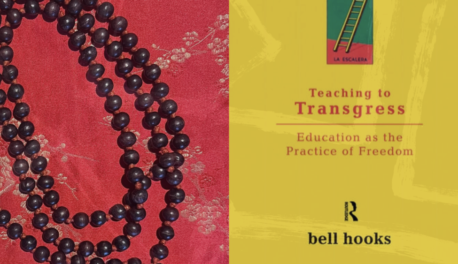
A-way to write
With bell hooks’ Teaching to Transgress open on her lap, she gently closes her eyes and focuses on her breath. In and out. Until now, she had never seen the words of Vietnamese Buddhist monk Thich Nhat Hanh [1]Thich Nhat Hanh, (1992), Peace is Every Step: The Path of Mindfulness in Everyday Life, Bantam. cited in a book on education, or a phrase like the “transformative power of love” offered as a path to resist “white supremacist capitalist patriarchy”[2]bell hooks, (1994), Teaching to Transgress, Routledge, p. 26.. Gently moving her finger from one mala bead to the next, the Green Tara mantra falls softly from her lips. “Om tara tuttare ture soha”, over and over 108 times. In and out. She remembers moments of unbearable love and suffering where in the teachings of Buddhism and hooks writing in relation, she found and felt affirmed that an ethic of “big love”[3]Adele Tomlin,(2023), “Everyone wants to be loved”, Tricycle: The Buddhist Review, 14 February. in action was a-way to endure, a-way to courage, a-way to freedom—and a-way to write. She holds onto her mala beads and begins the first of three turnings.[4]The Buddha’s scripture Samdhinirmocana Sutra sets out a pathway to enlightenment which consists of three phases or “turnings” of the Dharma wheel. Tenshin Reb Anderson explains this … Continue reading
“If I were really asked to define myself…I would start with stripping down to what fundamentally informs my life, which is that I’m a seeker on the path. I think of feminism, and I think of anti-racist struggles as part of it. But where I stand spiritually is, steadfastly, on a path about love.” [5]https://tricycle.org/magazine/bell-hooks-buddhism-love/
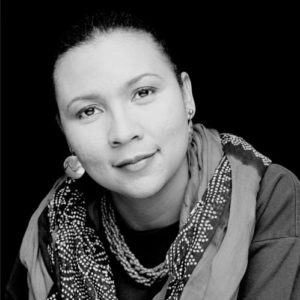
bell hooks
(1952-2021)
Black feminist writer, professor, teacher, cultural critic, activist-scholar, revolutionary
I take refuge in the Dharma[6]In Buddhism, there are “three jewels” in which we take refuge: the Buddha, the dharma and the sangha. Taking refuge does not mean retreating but rather commiting to ourselves to freedom … Continue reading
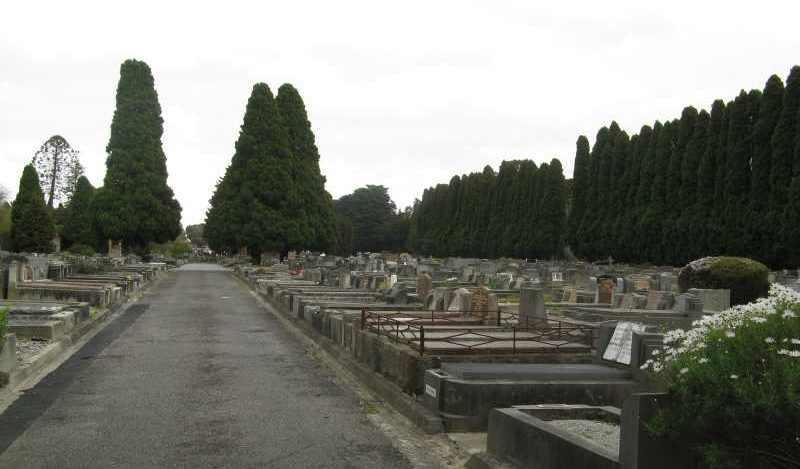
“I felt a Funeral, in my Brain, And Mourners to and fro/Kept treading – treading – till it seemed/That Sense was breaking through -And when they all were seated/A Service, like a Drum/Kept beating – beating – till I thought/My mind was going numb”.[7]Emily Dickinson, (1861), “I felt a funeral in my brain”, #360.
It had rained in Box Hill when they buried her, and the words of Emily Dickinson’s poem had become a mantra she woke and went to sleep to. The sadness of the sky had sat down inside her heart that day and her feet now left soggy footprints wherever she walked. She could not accept that her grandmother was gone. She would not kneel at the service; she could not throw dirt on the coffin, she would not raise her glass at the wake, and each night she went to sleep waiting for her grandmother Queenie to arrive singing and dancing in her dreams.
By chance one Monday evening she was working late on campus and paused to listen to the chanting, soft and low, coming from Building 6 on the Campus Ring Road as she walked by.
“Om ཨོཾ mani མ་ཎི padme པ་དྨེ hum ཧཱུྃ”.[8]This six syllable mantra literally means “the jewel is in the lotus”. For a wonderful explanation discussion of the meaning of this Tibetan mantra, see the following link on thearticle … Continue reading
Quietly she stepped inside, sat down cross-legged on a spare cushion at the back of the room and closed her eyes.
“Om ཨོཾ mani མ་ཎི padme པ་དྨེ hum ཧཱུྃ”.
She is gently brought back to the present by a hand which comes to rest on her shoulder. It belongs to Gerard[9]Gerard, the leader of the Tibetan Buddhist community at the University of New England, http://home.exetel.com.au/acbc/lamas/gerard-allan/ the leader of the Mahayana meditation sessions at the University of New England.
“Tell me,” he asks, “What is the cause of your suffering?”
bell hooks tells me, that her grandmother too was a figure in her dream life and that there is no death for an angel. She tells me, she too felt that dwelling in death was the only way to grapple with reasons to stay alive[10]bell hooks, (1999), Remembered Rapture: The Writer at Work, Henry Holt and Company, p. 8; but soon realised death is not an “end to life but simply another stage of growth”[11]bell hooks, Remembered Rapture, p. 190. tells me, there are many ways to move beyond[12]bell hooks, (2005), “Poem #24”, When Angels Speak of Love, Atria Books, p. 47. and our passion for written words opens the door to a room of one’s own, making space for our soul to come and see[13]bell hooks, (1999), Remembered Rapture, p. 190.. She tells me, amidst the suffering which is grief and loss born of love, choose which memories to keep and those to let go[14]bell hooks, (2005), “Poem #12”, When Angels Speak of Love, p. 23., be touched by their delight, and read, write, know. bell hooks tells me, here on these shores, surrender to the path that presents itself[15]bell hooks, Remembered Rapture, p. 128..
Gerard places a copy of The Tibetan Book of Living and Dying by Sogyal Rinpoche beside her.
“The life of beings is like a bubble and death comes often without warning”, his smile shrugs and gives into the reality of such impermanence. “All that is dear to us and everyone we love are of the nature to change.[16]In The Heart of the Buddha’s Teaching (1998, p. 124), Thich Nhat Hanh discusses the inevitable cycle of life-death-change by describing the five remembrances in Buddhism: that we are of the … Continue reading Embrace it as your teacher so that you might live and die well”.
She holds onto her mala beads and begins the second turning.[17]The second turning of the dharma wheel in Buddhism is called “encouragement” where after recognising suffering we take time to look deeply in order to understand its true nature (Thich … Continue reading
I take refuge in the Sangha[18]The term “sangha” means “to bring together” and in Pali and Sanskrit refers generally to “community”. In Buddhism it refers to “Buddhist community” and … Continue reading
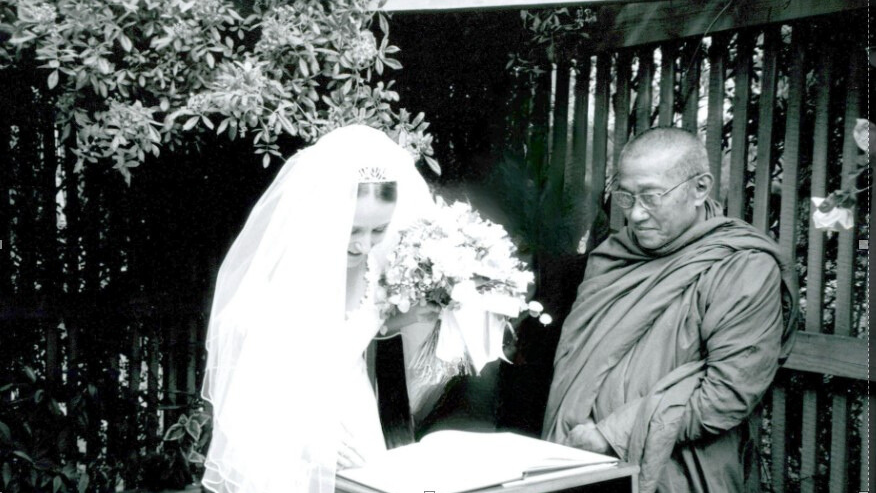
She remembers that it was raining softly just before the ceremony was about to begin. Dr Chamras Soonthornvitit, the Abbot at the Monash University Buddhist Society looked to the skies, laughed softly and assured her, “It falls and then calmly dies”. She remembers that she had held her father’s arm tightly in reassurance as she stepped carefully down the path to the rose garden where she was to be married.
With her family from Darwin and Burrulula in the north and Creswick and Melbourne in the south standing in a circle around them, she remembers reciting their vows in unison. “Today we pledge to help each other to develop our hearts and minds, cultivating compassion, generosity, ethics, patience, enthusiasm, concentration and wisdom as we age and undergo the various ups and downs of life and to transform them into the path of love, compassion, joy and equanimity”. Afterwards, she remembers sitting on a stone bench in the sun watching the spirit of big love wrap around her friends and family; such rapture here, there and everywhere as two souls joined as one; her spirit and his, both delighting in the possibilities that awaited them.
She remembers her older sister Sally finding her there, beaming and angling the camera in her direction.
“Bethy!”, she cries, “How much in love are you right now? Show me a smile and tell me!”
bell hooks tells me, that “love within the context of romantic bonding offers us the unique chance to be transformed in a welcoming celebratory atmosphere”.[19]bell hooks, (2018), All About Love: New Visions, Harper Collins, p. 188.. She tells me that intensely connecting with another soul, we are made bold and courageous…we are able to love truly and deeply, to give and receive a love that lasts, a love that is “stronger than death.”[20]bell hooks, All About Love, p. 188. bell hooks tells me to give love words, a clear definition and common understanding so that it is easier to love, be loved and create love in between.[21]bell hooks, All About Love, p. 11. She tells me, such words lay the “groundwork for the openness and honesty that is the heartbeat of love”[22]bell hooks, All About Love, p. 53. and “when love is the ground of our being, a love ethic”[23]bell hooks, (2022), “Towards a worldwide culture of love”, The Lions Roar, 8 November, p. 6, https://www.lionsroar.com/toward-a-worldwide-culture-of-love/ is cultivated. bell hooks tells me that here in the turning, pulling, planting, and watering, “if love and compassion are in our hearts, every thought, word and deed can bring about a miracle”.[24]bell hooks, “Towards a worldwide culture of love”, p. 10.
“What a beautiful picture!” Sally smiles.
She remembers Sally then hugging her so tightly she can feel their hearts beating, from one to another, drumming the most powerful and complicated rhythms possible. Sally stroked her hair, and she remembers her whispering cheek to cheek, “I do not know what the future holds for you Bethy, but I hope you will nourish one another until the end of your days”.
She holds onto her mala beads and begins the third turning.[25]The third turning of the dharma wheel is called “realisation” we acknowledge we have understood and stopped running away from our suffering (Thich Nhat Hanh, The Heart of the … Continue reading
I take refuge in the Buddha[26]“Buddha” is a Sanskrit word which means “one who is awake” and is not a name but rather a title. In common usage, we often hear the phrase “the Buddha” and the … Continue reading

She did as he asked, because she once loved him. She wrote to the coordinator of the Liberation Prison Project in Brisbane to find out if an ordained member of the Langri Tangpa Centre might be able to visit him in jail. She explained that he had lost his way and that she and her two boys were also suffering. Of course, they would support him in his Dharma practice was the reply, all she needed to do was to send his full name, prison ID number and they would send him some materials, offer him a Dharma mentor to write to, add him to the inmates mailing list and put her in touch with a monk or nun to begin the process.
She now sits precariously on the tall café stool and watches the woman walk towards her. She nervously smooths the folds of her yellow cotton sundress. The woman wears robes of deep red and simple brown sandals on her feet. Her head is shaved, and she knows immediately it is Venerable Lozang Trin-La, a Sangha Care Coordinator from Langri Tangpa.
“Liz?” Trin-La smiles warmly in recognition.
She looks at Trin-La and feels the thing with feathers slip in ever so quietly and perch on her soul.
“I have never visited anyone in jail before”, she says. “What do I need to do?”
She has lost count how many times she has been inside and spends the next 15 minutes explaining how to fill out Form 27, the importance of arriving on time, not to wear perfume or handle money, to grin and bear the intrusive guard pat downs, don’t sit in the red chair at the iron bolted to the floor table – that’s his, and how fast an hour flies by.
Trin-La nods.
“I will offer him spiritual support and advice, but I sense that you too are suffering”, Trin-la gently takes her hand, “Tell me”.
bell hooks tells me that suffering led her to Buddhism too.[27]bells hooks, (2008), “Moving beyond gender”, in Peter Gregory (Ed.), Women Practicing Buddhism: American Experiences, Wisdom Publications Inc., pp. 33-40. She tells me that unbearable emotional pain caused her to despair, contemplate suicide, and fall into an abyss of sorrow. bell hooks tells me that her longing to be a poet matched her longing to find a spiritual path and that one encounter with a Buddhist nun compelled her to maintain hope in the face of suffering. She tells me that committing to the path of mindfulness led her to a “practice of compassion that joins rather than separates, that takes the broken bits and pieces…of the self and the world”[28]bells hooks, “Moving beyond gender”, p. 39. and puts them back together. bell hooks tells me [29]bell hooks, “Towards a worldwide culture of love”. that once a relationship with a man she thought she loved left her feeling ashamed and angry. She tells me that the practice of love enabled her to find a way to understanding, forgiveness, and peace. bell hooks tells me that in a dualistic world dominated by imperialist-white-supremacist-capitalist-patriarchy practicing engaged Buddhism offers an alternative framework[30]bells hooks, “Moving beyond gender”, p. 36. – a place where her loving feminist critical consciousness can breathe without subjugation of mind and spirit or subordinating herself to male domination. She tells me that following a tradition of women who have opened their hearts to Buddhism is a radical act of love.
Trin-La reaches into her bag and hands her a postcard picturing Green Tara, the mother of all Buddhas “who ferries beings across the ocean”xxii of suffering.
“Think of her as your veil of protection”, Trin-La explains. “As you face the challenges ahead, call on and meditate with her; feel her love flow and help you spiritually, emotionally, and physically”.
She traces her finger around the lotus flower Green Tara holds.
“Is there a meditation practice you can suggest?”
“Om tara tuttare ture soha”, Trin-La shares the mantra. “Just google it and you’ll find plenty of You-tube versions, pick the one you like most and pour out your heart to her”.
I take refuge in writing
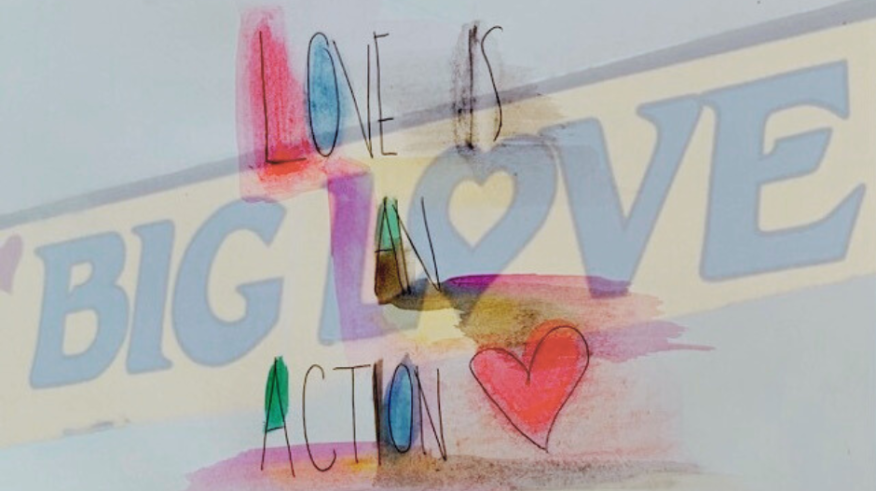
The colourful Tibetan prayer flags wave their welcome in the breeze. She spins the large dharma wheel clockwise ten times as she enters, chanting soft and low “Om ཨོཾ mani མ་ཎི padme པ་དྨེ hum ཧཱུྃ” in time with each revolution. She takes a seat in the Big Love Café at the Chenrezig Institute, sips on a cup of chai and reflects on the three turnings of experience she has shared in intimate connection with Buddhism and bell hooks. With minds and hearts fully awake, bell hooks in-sistered, we can engage in a practice of big love so strong it offers a way to end the suffering caused by dominator culture. Imagine all that would change! She thinks and wonders about autoethnography as a location of possibility to engage in a practice of big love, where there is “commitment and involvement with the world” to draw insight “about the way forces of domination fragment, estrange and assault our innermost beings, breaking us apart”[31]bell hooks, (1986), Talking Back: Thinking Feminist, Thinking Black, Routledge, p. 29. and “about the need to [put writing to work] to restore wholeness…as resistance to those forces”.
She holds onto her mala beads and offers a recitation.
For as long as space remains,
For as long as sentient beings remain,
So too shall I remain writing, guided by and grounded in big love.[32]This piece was originally prepared for and presented at the Critical Autoethnography annual conference “Love is an action” celebrating the work of bell hooks and held at RMIT, Melbourne … Continue reading
References
| ↑1 | Thich Nhat Hanh, (1992), Peace is Every Step: The Path of Mindfulness in Everyday Life, Bantam. |
|---|---|
| ↑2 | bell hooks, (1994), Teaching to Transgress, Routledge, p. 26. |
| ↑3 | Adele Tomlin,(2023), “Everyone wants to be loved”, Tricycle: The Buddhist Review, 14 February. |
| ↑4 | The Buddha’s scripture Samdhinirmocana Sutra sets out a pathway to enlightenment which consists of three phases or “turnings” of the Dharma wheel. Tenshin Reb Anderson explains this beautifully in “Why the wheel turns three times”, https://www.lionsroar.com/why-the-wheel-turns-three-times/. The first turning of the wheel is called “recognition” of suffering (Thich Nhat Hanh, (1998), The Heart of the Buddha’s Teaching, Rider, p. 29). |
| ↑5 | https://tricycle.org/magazine/bell-hooks-buddhism-love/ |
| ↑6 | In Buddhism, there are “three jewels” in which we take refuge: the Buddha, the dharma and the sangha. Taking refuge does not mean retreating but rather commiting to ourselves to freedom and finding a place to embrace the complexities of life. The word “dharma” derives from the Sanskrit verb dhri meaning to “hold” or “maintain”. One of the most common words in Buddhism, dharma is often used to refer “teachings” or “doctrines,” both Buddhist and non-Buddhist. The first sermon the Buddha gave after reaching enlightenment was called “turning the wheel of dharma” and the orginal meaning of the word is evoked to refer to “holding back suffering”. https://tricycle.org/magazine/many-meanings-dharma/ Thich Nhat Hanh provides the following description” “Dharma is the clear path leading us out of ignorance bringing us back to an awakened life” (The Heart of the Buddha’s Teaching, p. 167) and it is one I find myself returning to often. |
| ↑7 | Emily Dickinson, (1861), “I felt a funeral in my brain”, #360. |
| ↑8 | This six syllable mantra literally means “the jewel is in the lotus”. For a wonderful explanation discussion of the meaning of this Tibetan mantra, see the following link on thearticle provided by the Tibetan Nun’s Project: https://tnp.org/the-meaning-of-om-mani-padme-hum/ |
| ↑9 | Gerard, the leader of the Tibetan Buddhist community at the University of New England, http://home.exetel.com.au/acbc/lamas/gerard-allan/ |
| ↑10 | bell hooks, (1999), Remembered Rapture: The Writer at Work, Henry Holt and Company, p. 8 |
| ↑11 | bell hooks, Remembered Rapture, p. 190. |
| ↑12 | bell hooks, (2005), “Poem #24”, When Angels Speak of Love, Atria Books, p. 47. |
| ↑13 | bell hooks, (1999), Remembered Rapture, p. 190. |
| ↑14 | bell hooks, (2005), “Poem #12”, When Angels Speak of Love, p. 23. |
| ↑15 | bell hooks, Remembered Rapture, p. 128. |
| ↑16 | In The Heart of the Buddha’s Teaching (1998, p. 124), Thich Nhat Hanh discusses the inevitable cycle of life-death-change by describing the five remembrances in Buddhism: that we are of the nature to grow old, we are of the nature to have ill-health, we are of the nature to die, everyone and everything we love will change, and our actions are our true belongings and the ground upon which we stand. They are not easy to remember because they spek to impermanence but each day I try not forget. |
| ↑17 | The second turning of the dharma wheel in Buddhism is called “encouragement” where after recognising suffering we take time to look deeply in order to understand its true nature (Thich Nhat Hanh, The Heart of the Buddha’s Teaching, p. 29). |
| ↑18 | The term “sangha” means “to bring together” and in Pali and Sanskrit refers generally to “community”. In Buddhism it refers to “Buddhist community” and can be extended to encompass all sentient beings. This vision brings a heightened sense of connection, mutual interdependence and a shared responsibility (Andrew Olendzki, 2020, “What’s in a word? Sangha” Tricycle, Summer, https://tricycle.org/magazine/sangha-meaning/). “Sangha”, writes Thich Nhat Hanh, “is the beautiful community that practices joy, realising liberation, brining peace and happiness to life” (The Heart of the Buddha’s Teaching, p. 167). |
| ↑19 | bell hooks, (2018), All About Love: New Visions, Harper Collins, p. 188. |
| ↑20 | bell hooks, All About Love, p. 188. |
| ↑21 | bell hooks, All About Love, p. 11. |
| ↑22 | bell hooks, All About Love, p. 53. |
| ↑23 | bell hooks, (2022), “Towards a worldwide culture of love”, The Lions Roar, 8 November, p. 6, https://www.lionsroar.com/toward-a-worldwide-culture-of-love/ |
| ↑24 | bell hooks, “Towards a worldwide culture of love”, p. 10. |
| ↑25 | The third turning of the dharma wheel is called “realisation” we acknowledge we have understood and stopped running away from our suffering (Thich Nhat Hanh, The Heart of the Buddha’s Teaching, p. 31. |
| ↑26 | “Buddha” is a Sanskrit word which means “one who is awake” and is not a name but rather a title. In common usage, we often hear the phrase “the Buddha” and the reference is to Siddartha Gautama who lived in Northern India/Nepal around 2,500 years ago. Sometimes called Shakyamuni, he was not a god but an ordinary man who having recognised that the world was full of suffering, sat under a bodhi tree until he found the path to enlightenment and an end to suffering. The image of Arthur Gorrie prison in Wacol, Brisbane is confronting but it is the events in my life associated with this place that reignited my commitment to the three jewels and helped me to reset my life’s pathway. |
| ↑27 | bells hooks, (2008), “Moving beyond gender”, in Peter Gregory (Ed.), Women Practicing Buddhism: American Experiences, Wisdom Publications Inc., pp. 33-40. |
| ↑28 | bells hooks, “Moving beyond gender”, p. 39. |
| ↑29 | bell hooks, “Towards a worldwide culture of love”. |
| ↑30 | bells hooks, “Moving beyond gender”, p. 36. |
| ↑31 | bell hooks, (1986), Talking Back: Thinking Feminist, Thinking Black, Routledge, p. 29. |
| ↑32 | This piece was originally prepared for and presented at the Critical Autoethnography annual conference “Love is an action” celebrating the work of bell hooks and held at RMIT, Melbourne from 27-29 September, 2023. I’ve slightly revised it here so that the emphasis is on writing more generally than autoethnography. Those of you who know my work know that autoethnography and writing are one and the same. Thank you to all who were there and held my words with so much love. The piece also builds on earlier work, Chapter Three in Writing Feminist Autoethnography where I think and write with bell hooks words and work as a-way to love. |
Hearing this work previously at CAE, and reading it here now, moves me emotionally. Your words resonate. I feel with you more deeply as I sit here with your words. I am reminded that forgiveness in the spirit of love truly does relieve suffering. And really, it is the only way forward. It truly is love as an action. Thank you for being you.
Thank you Dawne for taking time to read this piece. Turning it over for in-sister after performing it at CAE was a nice way to bring it all full circle and a reminder once more that love is an action – and writing is one of the most powerful ways I know how to do that work of love. xo
Finally made time to read this and like Dawne, so moved to be reading it again, the memory of your spoken word still vibrant in my mind. i am reading Freya Mathews’ Ardea at the moment and when i read “Ethics is premised on empathy for all living things (p.34)” i thought of you and Buddhism and remembered this piece … Love you bigtime xxx